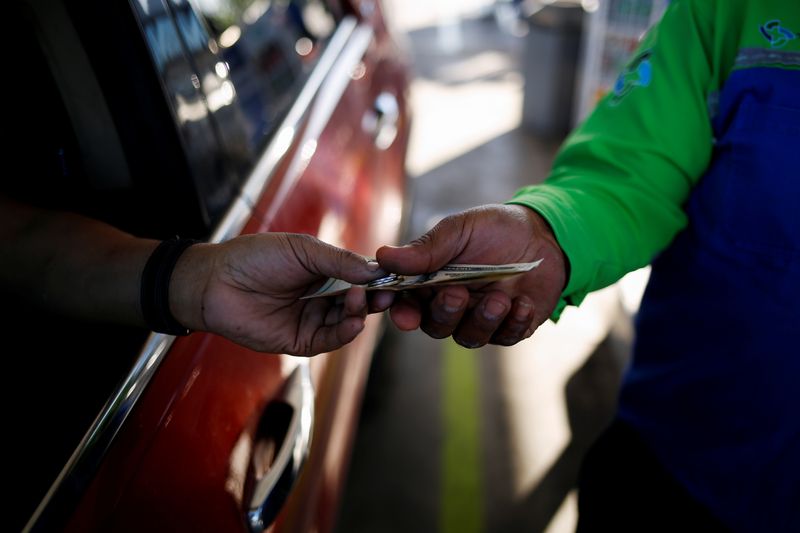By John Kemp
LONDON -U.S. households are in a more comfortable financial position than before the pandemic but surging inflation has started to erode those gains, stirring a sense of insecurity and anger about price increases.
Households and non-profit organisations owned liquid assets worth $18.5 trillion at the end of March 2022 up from $14.3 trillion at the end of March 2019, after adjusting for inflation, data from the Federal Reserve showed.
Liquid assets include currency as well as balances in checking accounts, time deposit accounts and money market funds, all of which are readily available to spend (“Flow of funds accounts of the United States”, June 9).
Liquid assets accumulated at a record rate in 2020 and 2021 because of pandemic-enforced restrictions on travel and social spending as well as the stimulus payments made by the federal government.
During the most intense periods of lockdown in the second quarter of 2020 and the first quarter of 2021, households were saving at annualised rates of $4-$5 trillion.
More recently, however, the inflation-adjusted value of liquid assets has been flat or falling as households have been able to travel and socialise again while rising prices have cut the real value of balances.
In real terms, liquid assets at the end of the first quarter of 2022 were down slightly from $18.7 trillion at the end of the first quarter of 2021 (https://tmsnrt.rs/3o2lLRn).
Real balances are likely to fallen much more sharply since then as most of the remaining travel restrictions have been lifted while inflation has surged.
The fact that households’ real liquid assets are high but falling fast explains why current spending remains strong but consumers and voters say inflation is their top concern and the economy is on the wrong track.
The resilience of consumer spending in the face of rapidly escalating food, fuel and other bills will depend on whether households focus on the level of their real liquid assets (high) or the rate of change (falling fast).
It also depends how long rapid inflation is expected to persist and continue eroding the value of their existing savings and ability to add to them.
SENTIMENT AT RECORD LOW
Consumers expect prices to rise at annualised rates of 5.2% over the next year and 2.8% over the next five years, both much faster than the central bank’s target (“Survey of consumers”, University of Michigan, July 15).
The proportion of households saying they are better off financially than a year before dropped to 37% in May 2022 from 42% in May 2021, while the proportion saying they are worse off leapt to 46% from 22%.
Among respondents who said they were worse off, the most commonly cited reason was higher prices (38%) and this was true for those in the lowest third of the income distribution (39%) as well as the top third (33%).
More respondents said higher prices were making them worse off (38%) than that higher income was making them better off (34%).
For respondents in the bottom third of the income distribution, the gap was even wider, with far more citing higher prices for making them worse off (39%) than citing higher incomes for making them better off (25%).
Reflecting the impact of inflation, the consumer sentiment index fell to a record low in June (50.0), worse than during the financial crisis in 2008 (55.3), the recession in 1980 (51.7) or the aftermath of the oil shock in 1975 (57.6).
There has been only a slight improvement in the first part of July, with preliminary results showing the sentiment index increasing marginally to 51.1.
CONTINUING TO SPEND, OR NOT?
Households still have the financial resources to continue spending for the next year or more by running down the savings that they built up during the pandemic.
But this is an aggregate and it is likely many households in the lower part of the income distribution are already exhausting their reserves and becoming spending-constrained.
Crucially, household and business narratives and psychology around spending already show many of the traits associated with the onset of a recession (“Narrative economics”, Shiller, 2017).
There are already anecdote-based news reports of households trading down to cheaper brands, limiting weekly spending on food and gasoline, and postponing non-essential spending.
Businesses in many sectors have begun to pare back hiring, consider reducing headcount, and pause capital investment.
Persuading households to continue spending depends on convincing them growth will continue and that inflation will be brought under control to stem the erosion in their financial position.
Running down savings is psychologically unpleasant when it is associated with rising prices and costs rather than increased consumption, which explains the sour mood picked up in surveys.
Households are already starting to push back; they may not be able to do much about rising prices as consumers but as voters they can punish those they hold responsible.
Related columns:
– Global business cycle starts to turn down (Reuters, June 30)
– Global consumers balk at surging prices for durable goods (Reuters, April 26)
– Escalating U.S. inflation forces macro policy rethink (Reuters, Jan. 13)
– Global economy faces biggest headwind from inflation (Reuters, Oct. 14)
John Kemp is a Reuters market analyst. The views expressed are his own
(Editing by Barbara Lewis)

